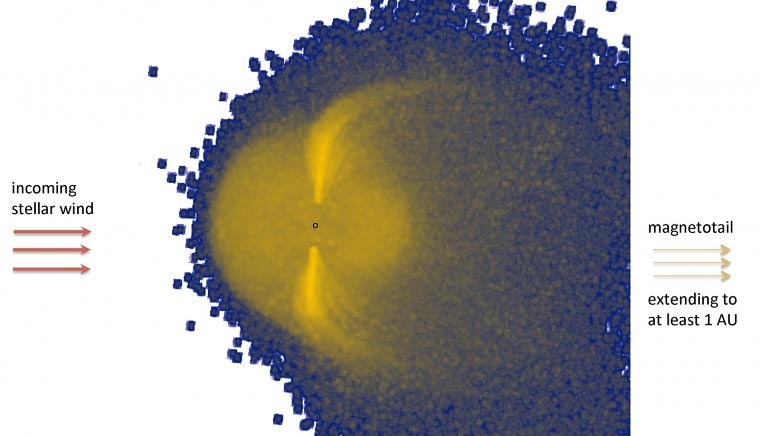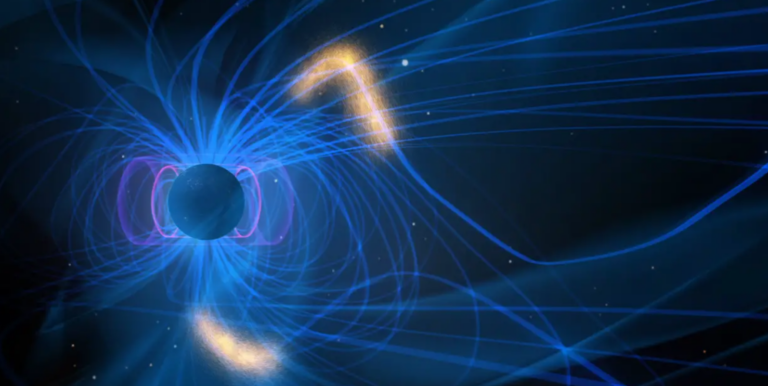Discovery Marks First Evidence of a Magnetic Field on a Planet Beyond Our Solar System
A team of international scientist were able to discern the obvious signs of a magnetic field through data collected from the Hubble Space Telescope of a planet located in another solar system.
The discovery is the first time scientists have detected the presence of such a feature on an exoplanet and is outlined in a research article in the Nature Astronomy. The idea of an expanded region filled with charged carbon particles and stretching behind the planet and out into the tail, can only be attributed to the presence of magnetic field.
The ability to spot the fields of exoplanets is a step towards potentially painting a picture of exactly what these far flun worlds could look like given magnetic fields are important for protecting planetary atmospheres. The Earth-based astronomers employed the Hubble to study HAT-P-11b, Neptune-sized planet which is located in 123 light-year away from us and given six “transits” during which the planet passed directly through the front of its parent star.
These observations were made in what could be considered a rather peripheral range of human visual ability, in the ultraviolet light spectrum. Astronomers found carbon ions in a region of the planet’s magnetosphere that is composed of charged particles affected by magnetic fields with Hubble.
Magnetosphere of any celestial body such as the earth is a region that is generated through interaction between the celestial body and the solar wind coming from the host star.

The paper’s co-author Gilda Ballester of the university’s Lunar and Planetary Laboratory said: “This is the first time that astronomers have been able to directly detect the imprint of a magnetic field of an exoplanet outside the solar system. “A large magnetic field around a planet like Earth acts as a shield that protects the surface and the atmosphere of the planet from direct force and impact of the particles in the solar wind. These processes
The magnetic field of HAT-P-11b’s has been detected which is crucial move towards the determination of an exoplanet’s habitability. The researchers report that not every planet and moon of the solar system possesses a magnetic field individual to it, and a lot more needs to be learnt concerning the correlation between magnetic fields and habitability of planets.
Besides stating that this general technique could be used to detect magnetospheres on a range of exoplanets and to evaluate the magnetospheres’ potential in possible habitability, Ballester said, “HAT-P-11 b has been found to be a very interesting target because Hubble’s UV transit observations resulted in the detection of a magnetosphere,” which is viewed as an ion component around the planet, as well as a long ion tail
Ballester was also involved in the decision making of this specific object for UV investigations as a principal investigator of one of the Hubble Space Telescope programs aimed at HAT-P-11b. The discovery of carbon ions in a long tail that stretched out away from the planet at average velocities of 100,000 mph, and a region around the planet was another big find. It was seen that part of the tail had gone at least one astronomical unit or the distance between the Earth and the Sun.
The complex relationships between it upper most layers of its atmosphere and magnetic field and the oncoming solar wind were then mathematically simulated in 3D by astrophysicists from the Institute of Astrophysics in Paris and their leader, for the paper, Lotfi Ben-Jaffel.
However, to some extent, it becomes possible to have interactions of the magnetic field of HAT-P-11b with its surrounding space and the solar wind from its host star; there is a complexity here similar to the interaction of the Earth’s magnetic field with its surrounding space, including the impinging solar wind made up of charged particles traveling at nearly 900,000 mph, “explains Ballester.
The planet’s outer atmosphere is heated and in essence evaporates into space given that it orbits at a distance 0. 05 of the distance of the Earth from the Sun, however the physical processes in the magnetospheres of both, Earth and HAT-P-11b are the same. Consequently, we have the creation of the magnetotail.
Together with the above findings, the scientists also determined that the metallicity of the outer atmosphere of HAT-P-11b, that is, the amount of chemical elements other than hydrogen and helium present in an object, is also less than expected. The substantially more massive gaseous planets in the solar system, Jupiter and Saturn lack metals, and have strong magnetic fields and, the ice giants Neptune and Uranus are metal rich but have only moderate magnetic fields. HAT-P-11b orbits a mild metal-poor star, which the authors state is problematic for current models of exoplanet formation.
“Despite the fact that mass of HAT-P-11b is only 8% of the Jupiter’s mass we do believe HAT-P-11b has all characteristics of mini-Jupiter and not Neptune,” Ballester said. Thus, the observations of the composition of the gaseous surrounding of HAT-P-11b are pointing out to the need for further study of the existing concepts about the formation of some classes of exoplanets in particular.
Do not forget to share your opinion with us to provide you with the best posts !




0 Comments